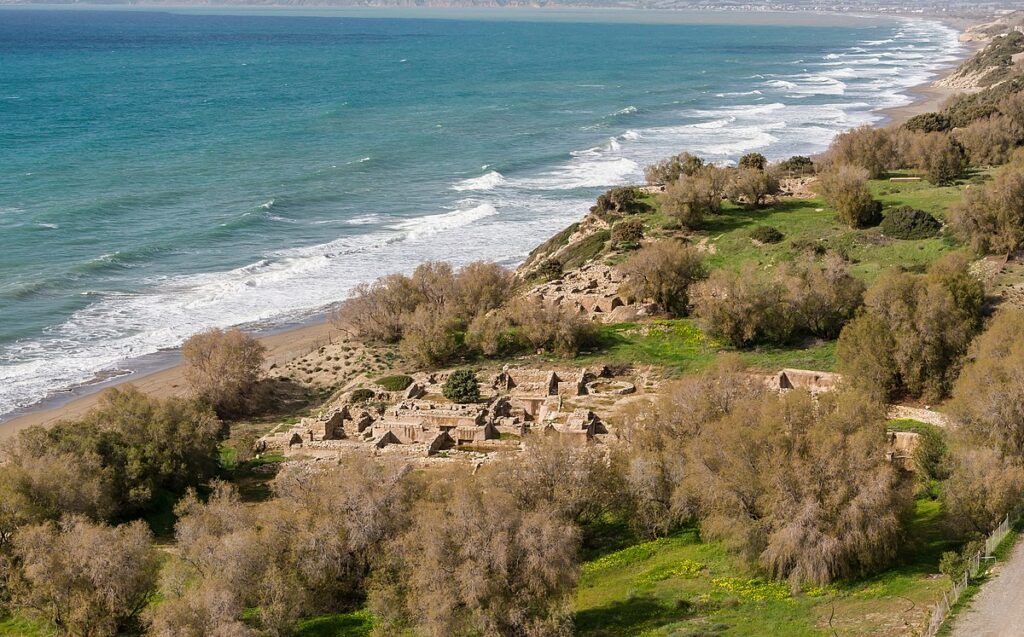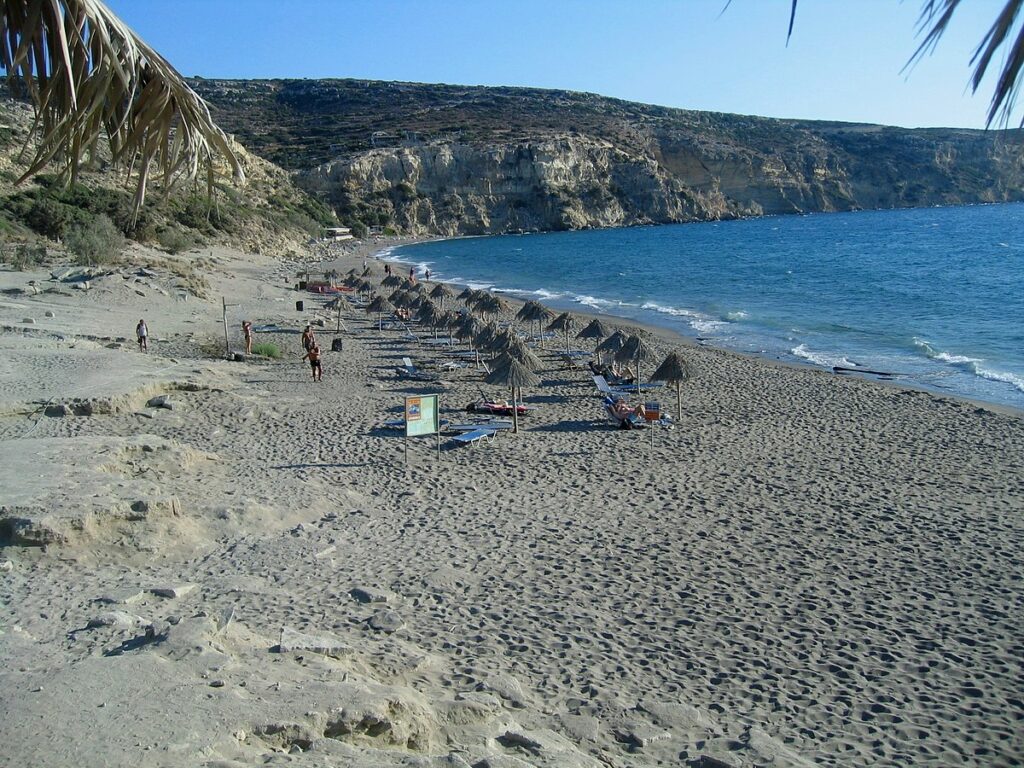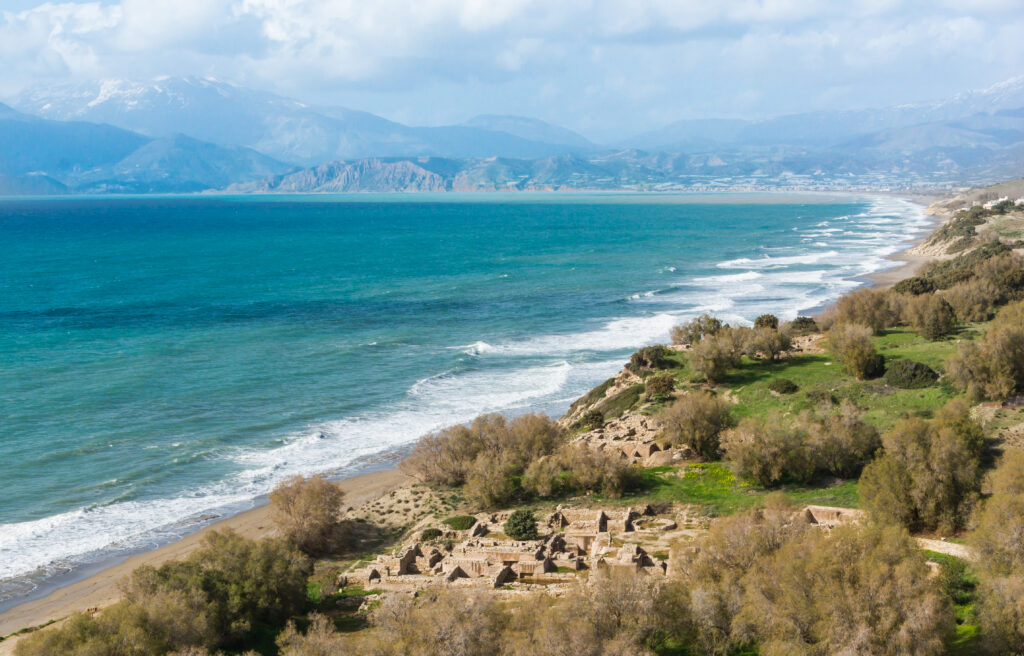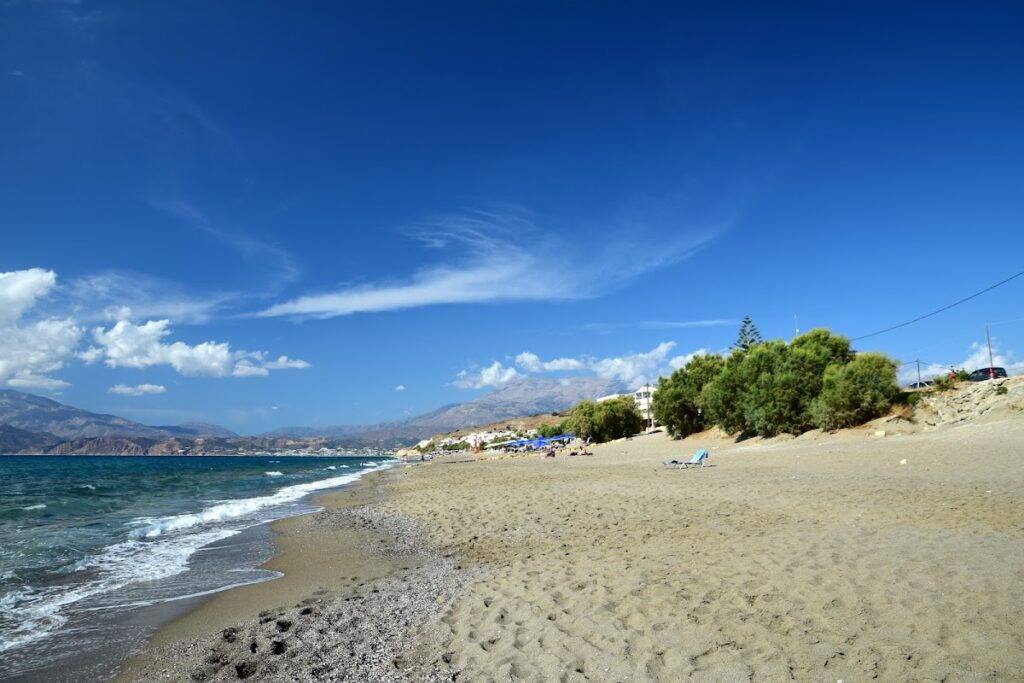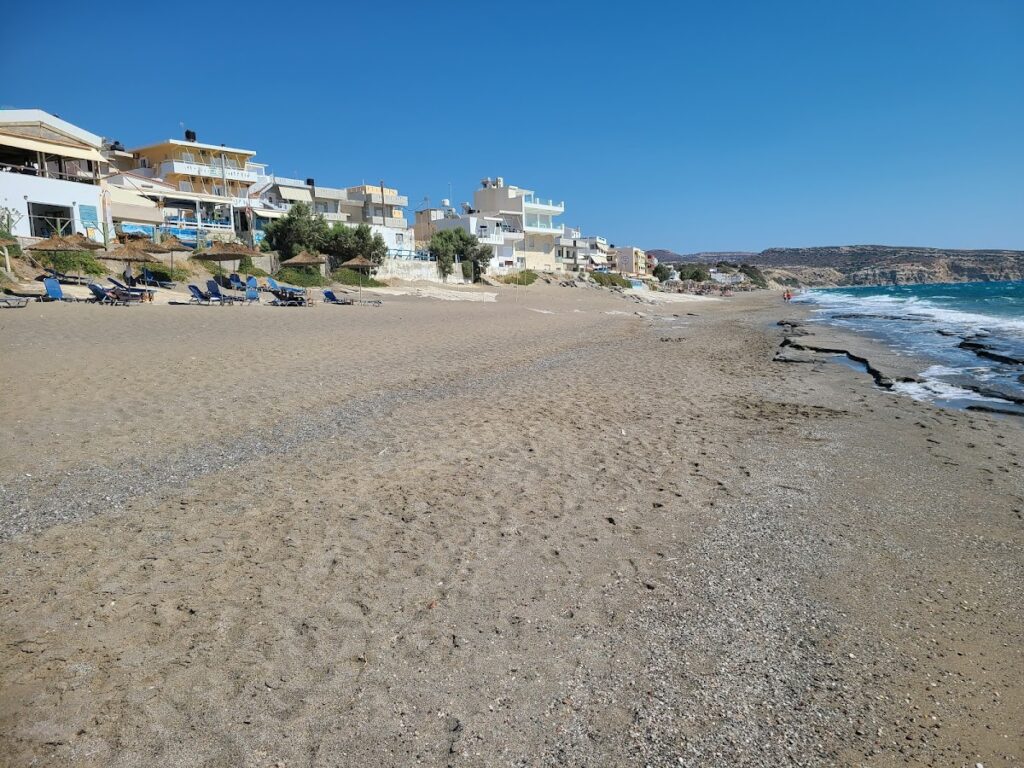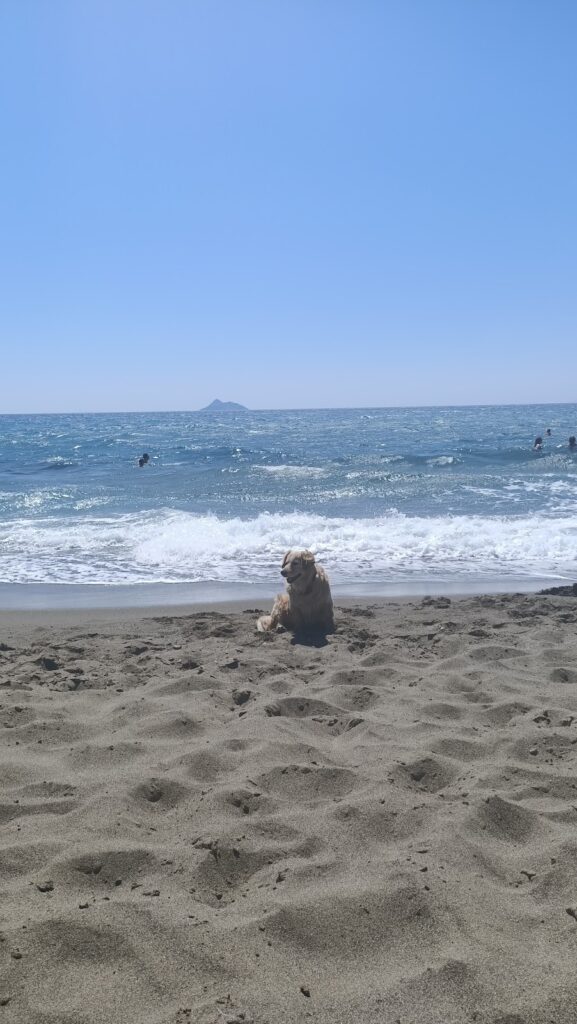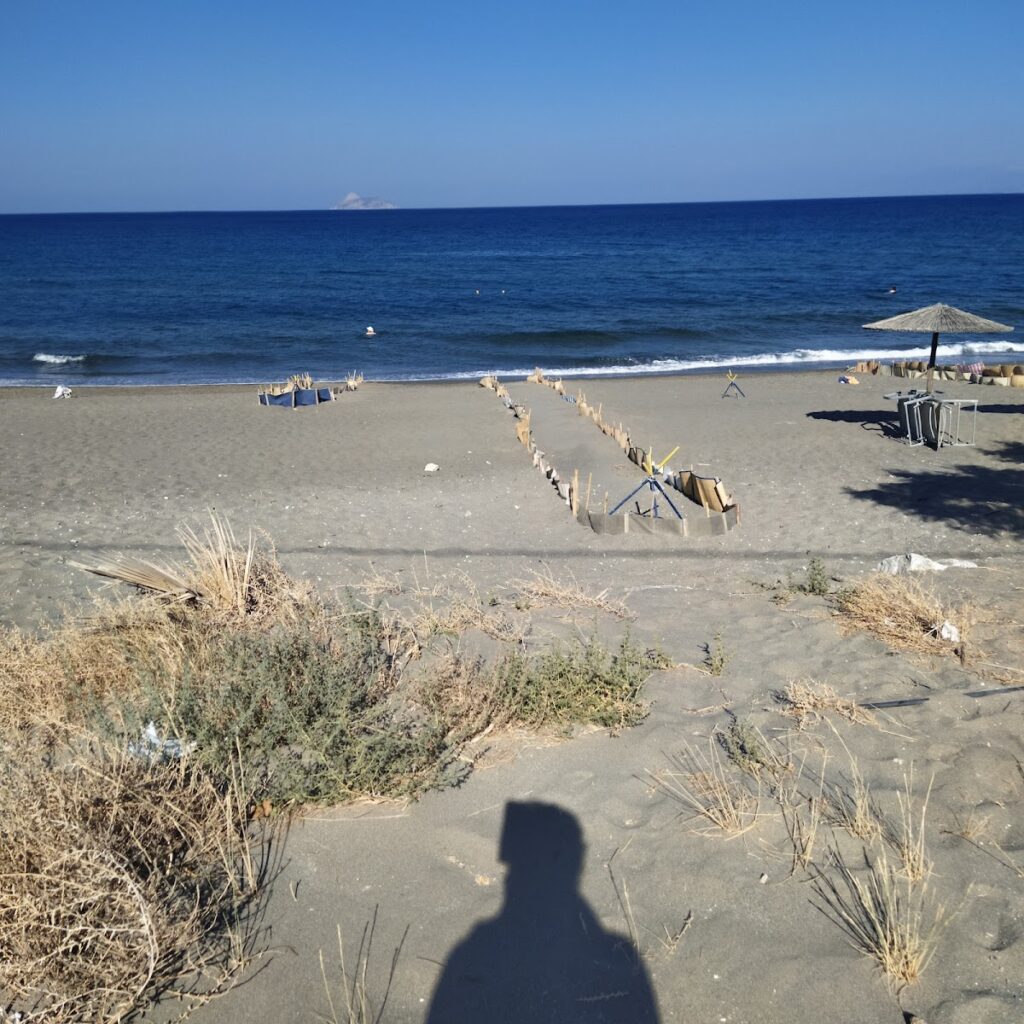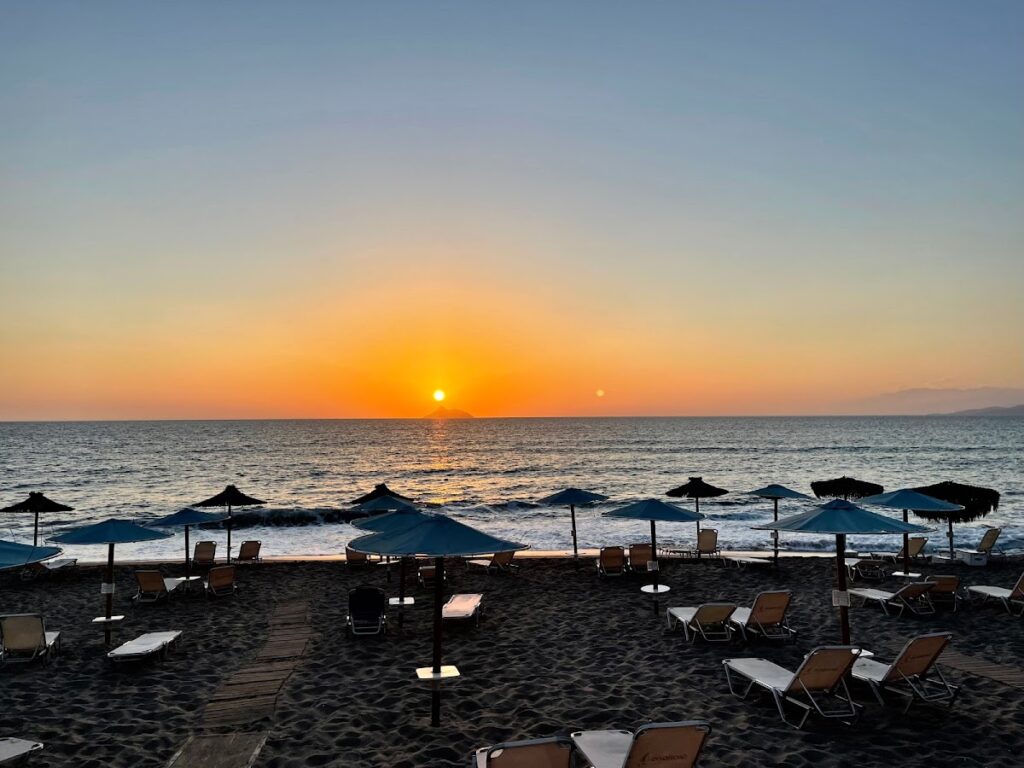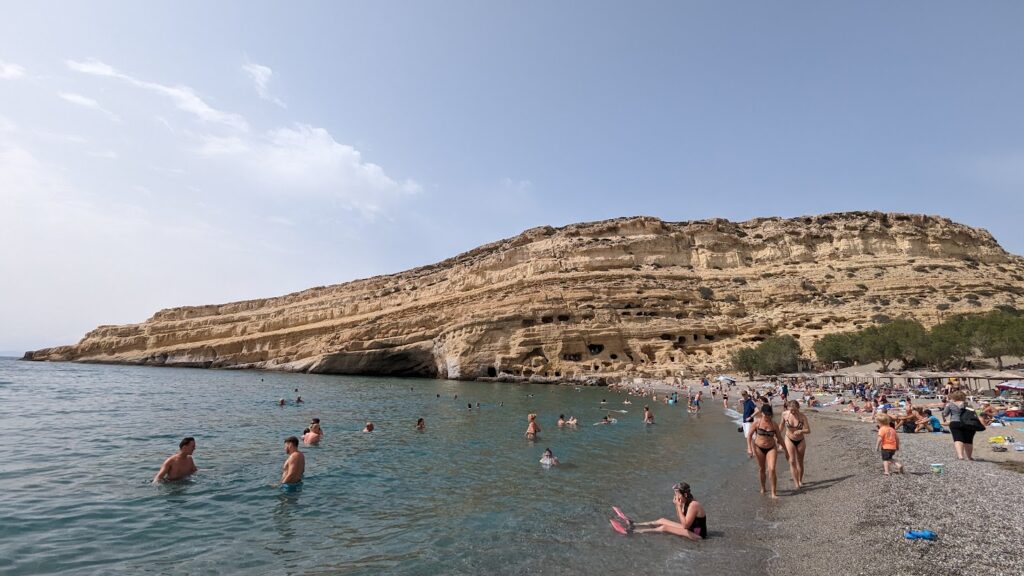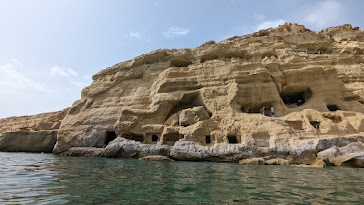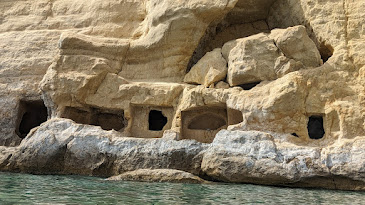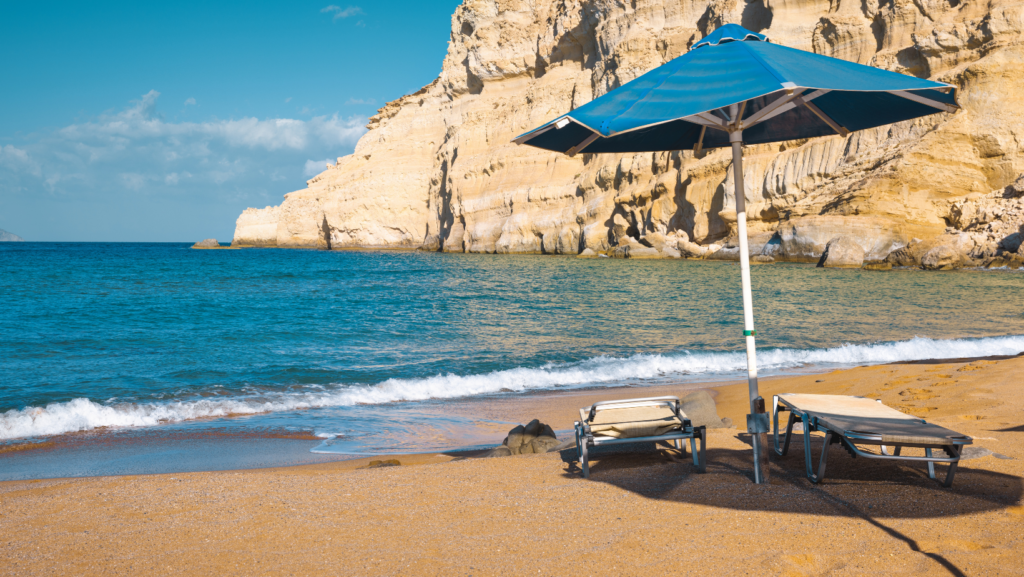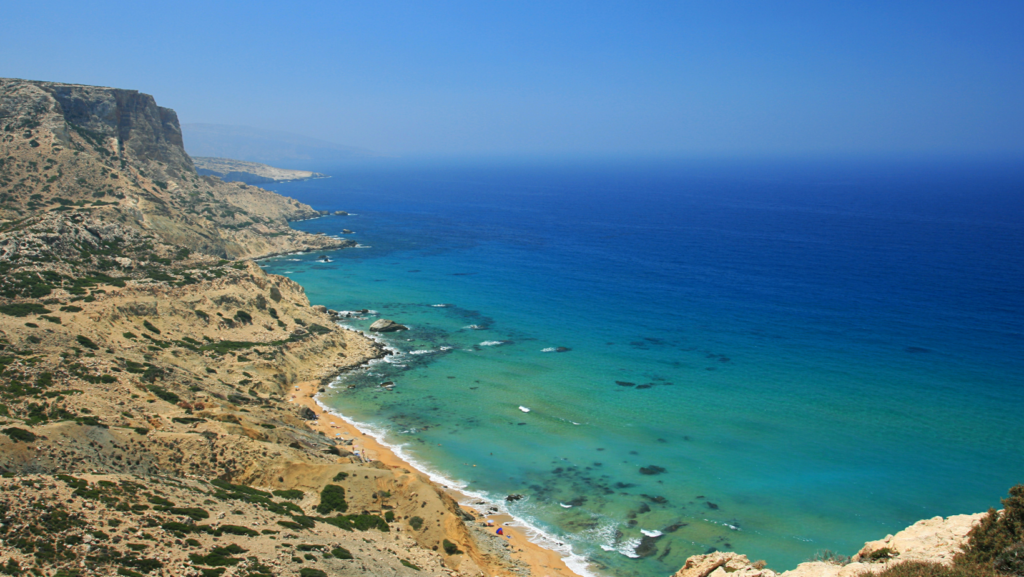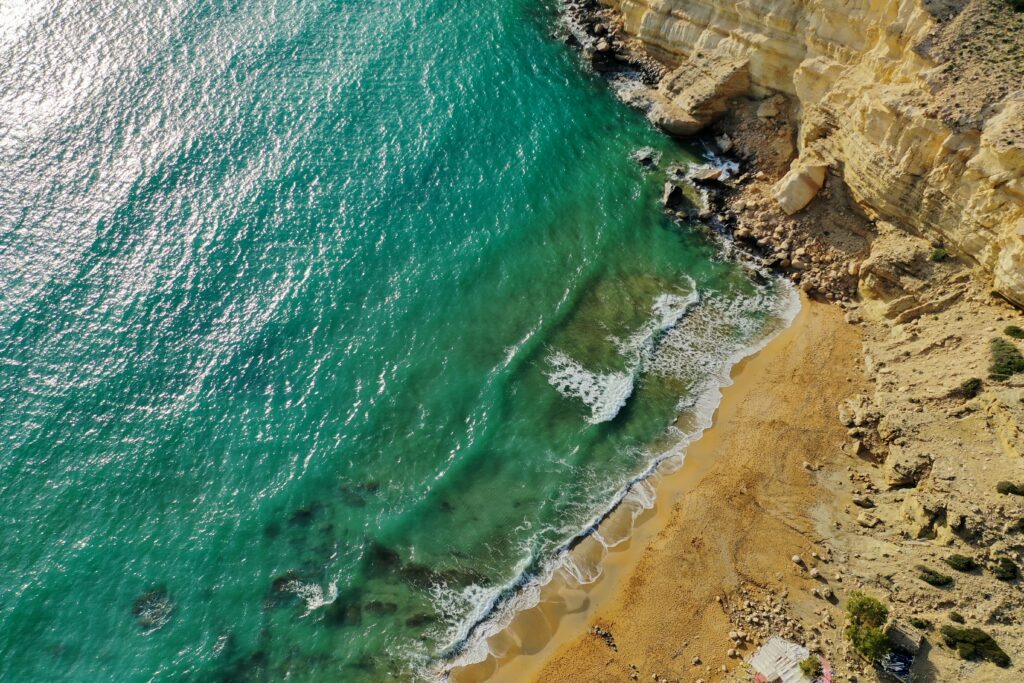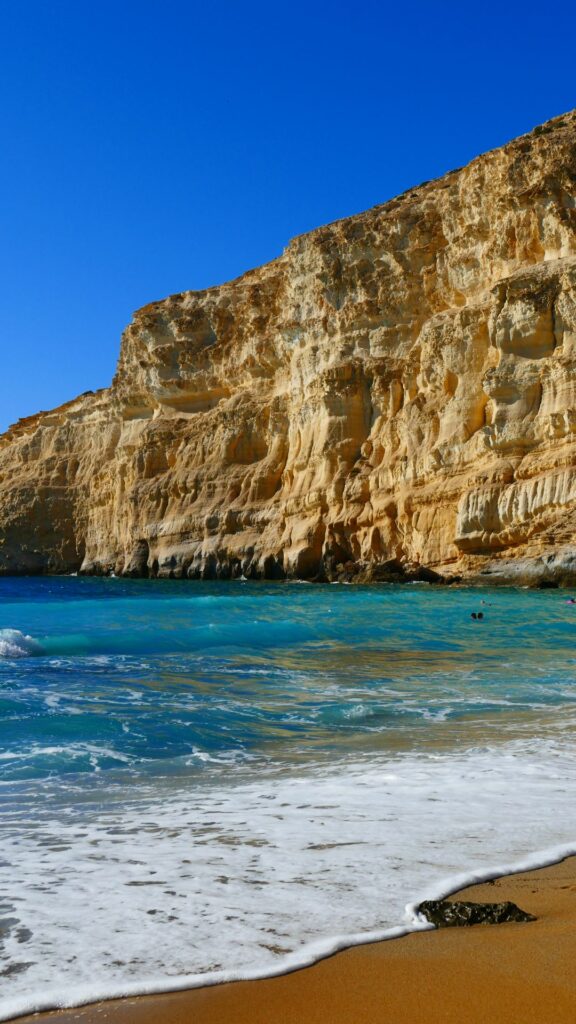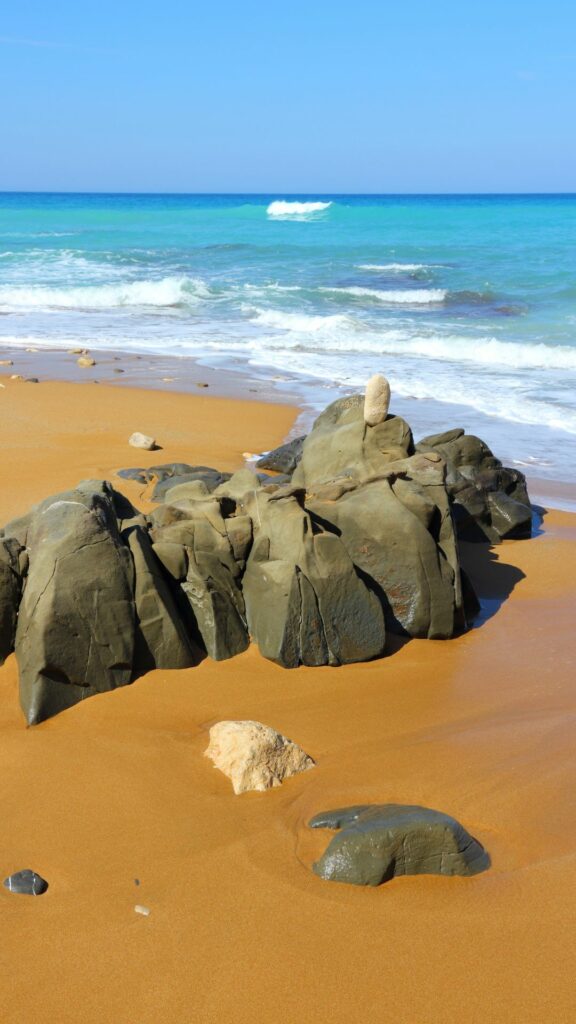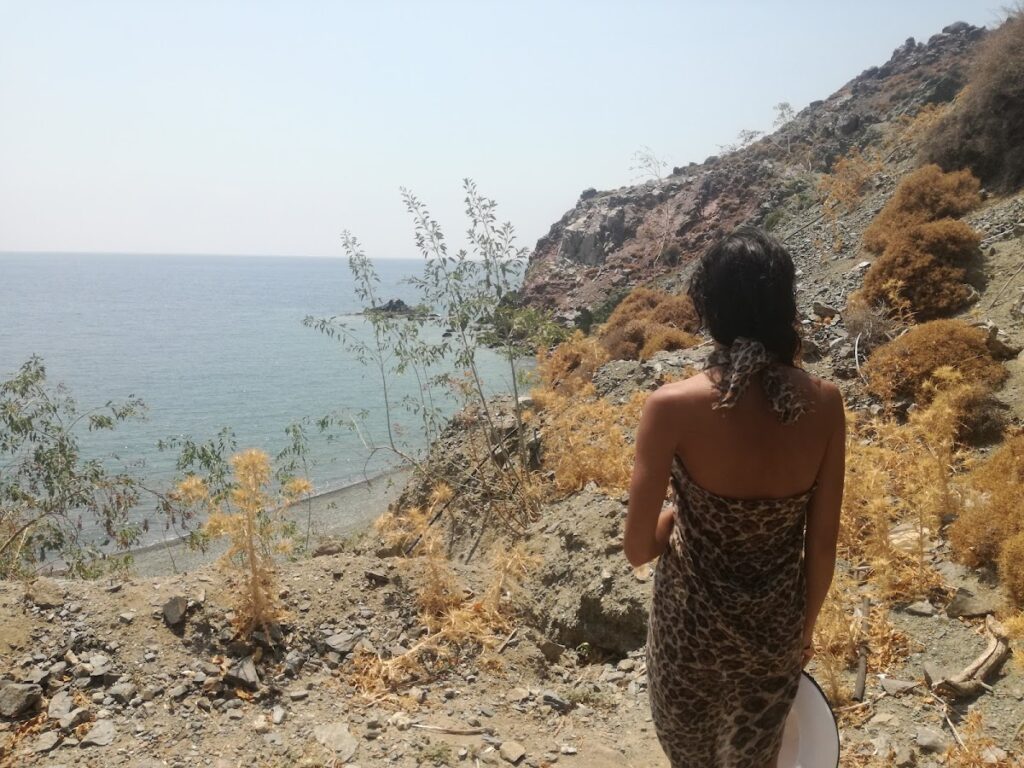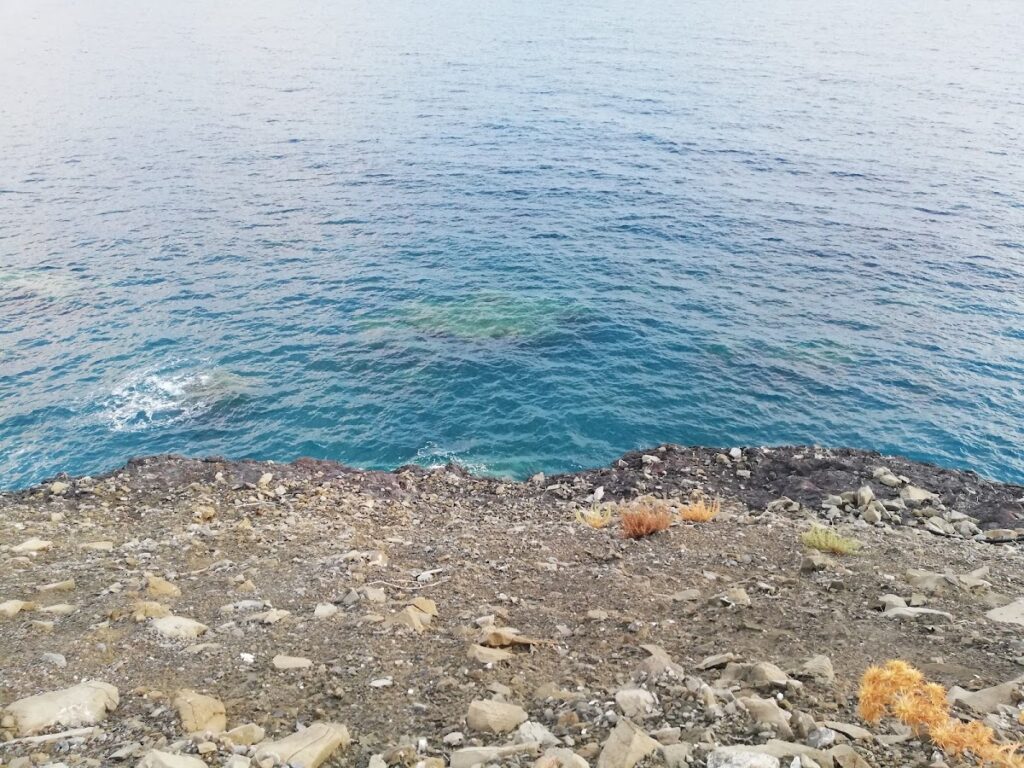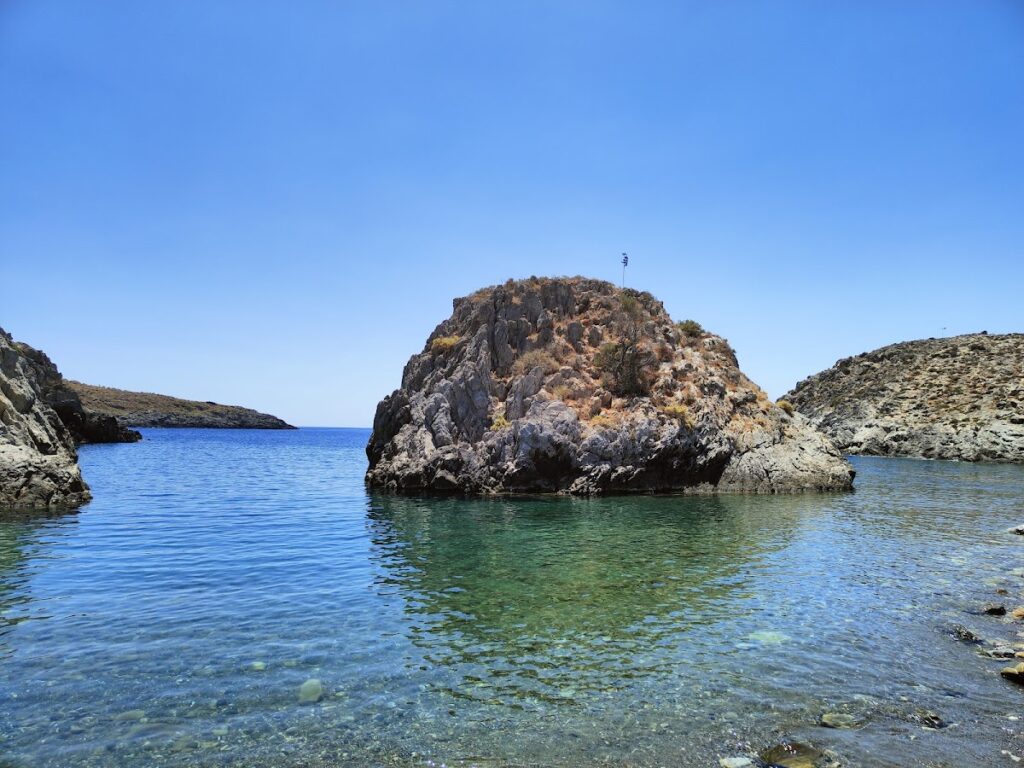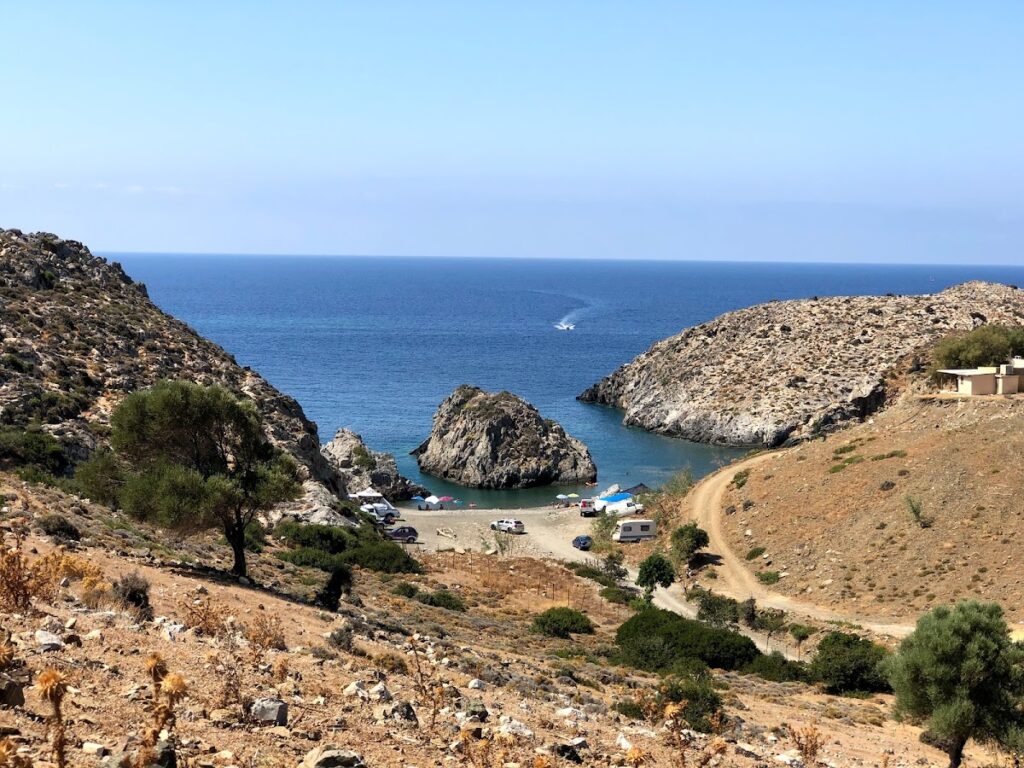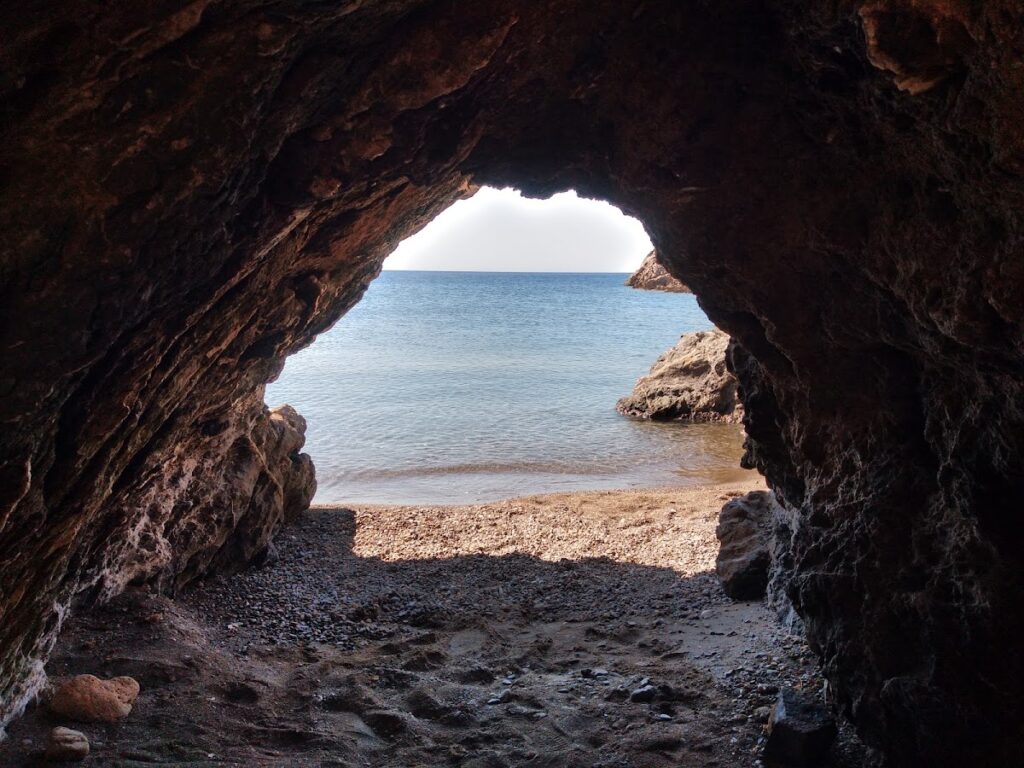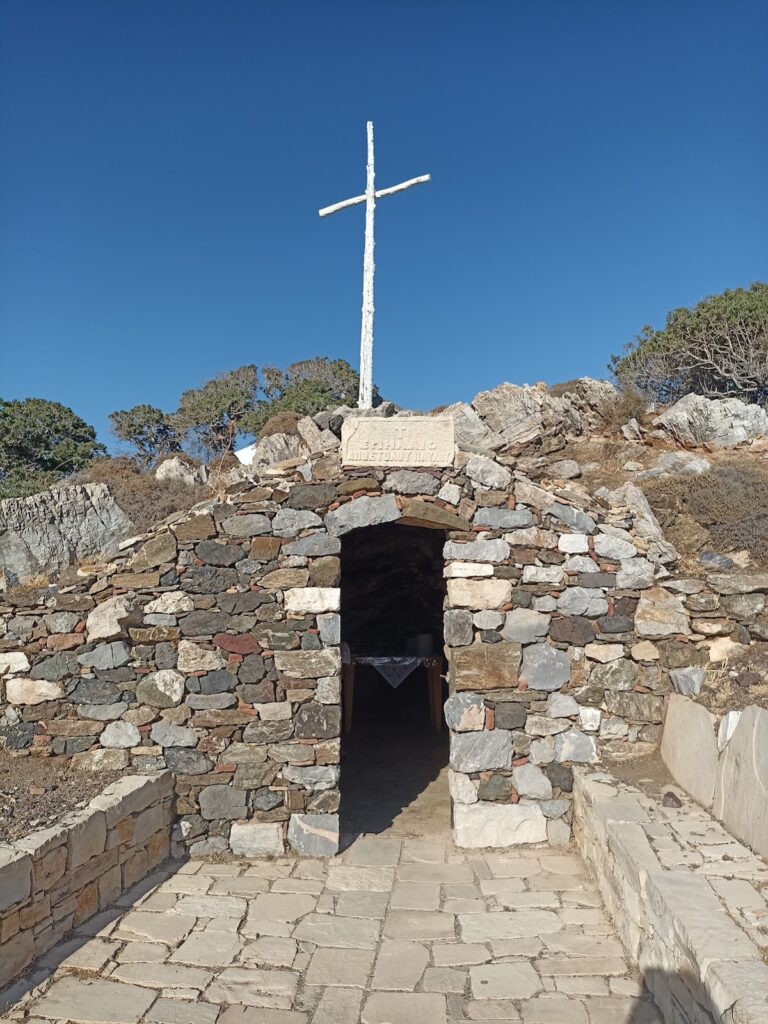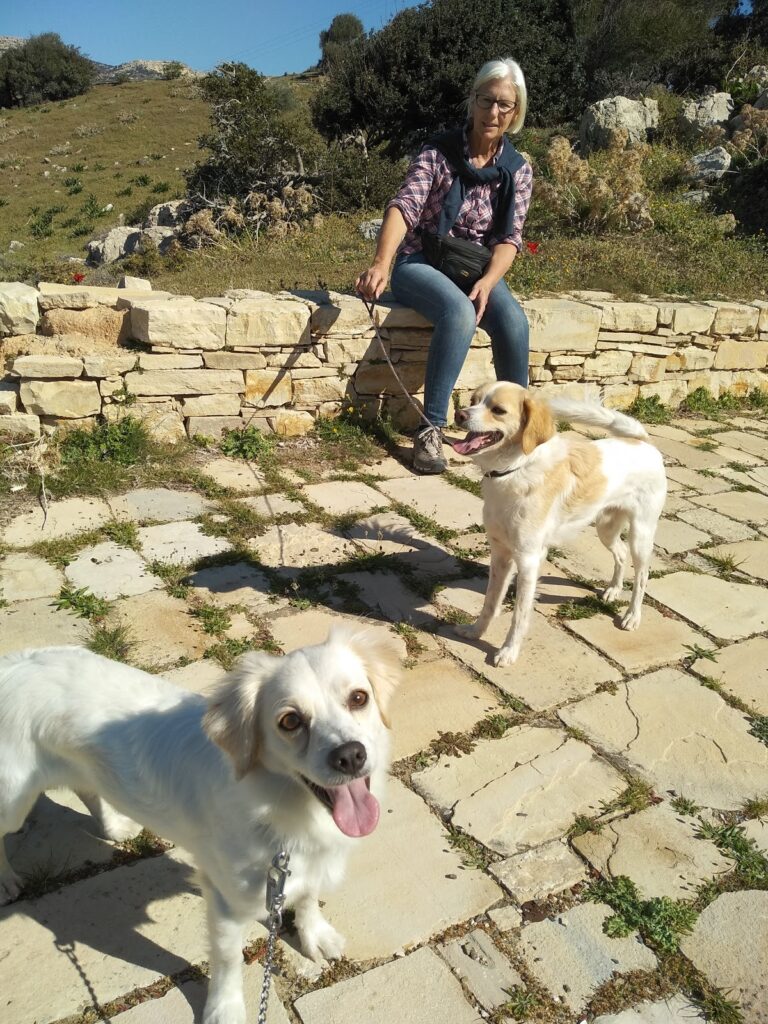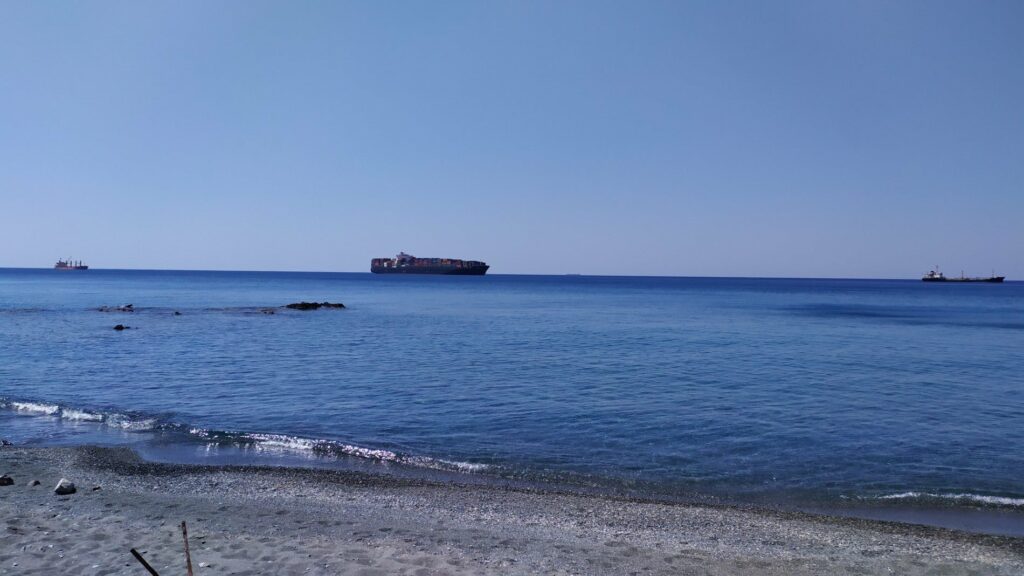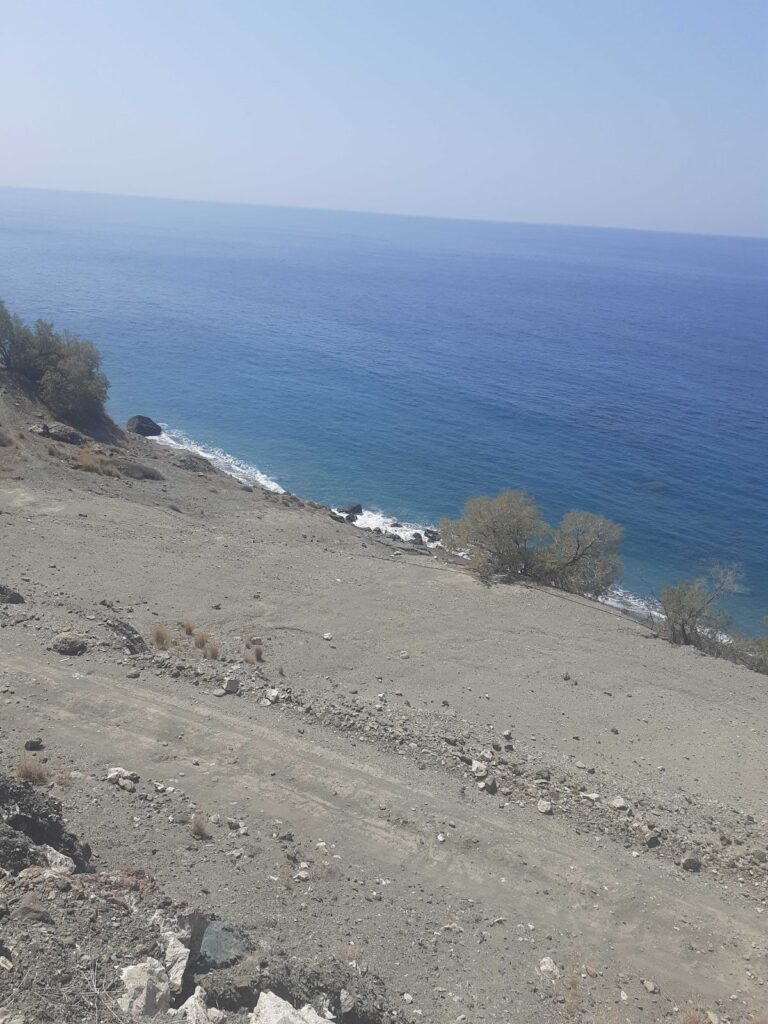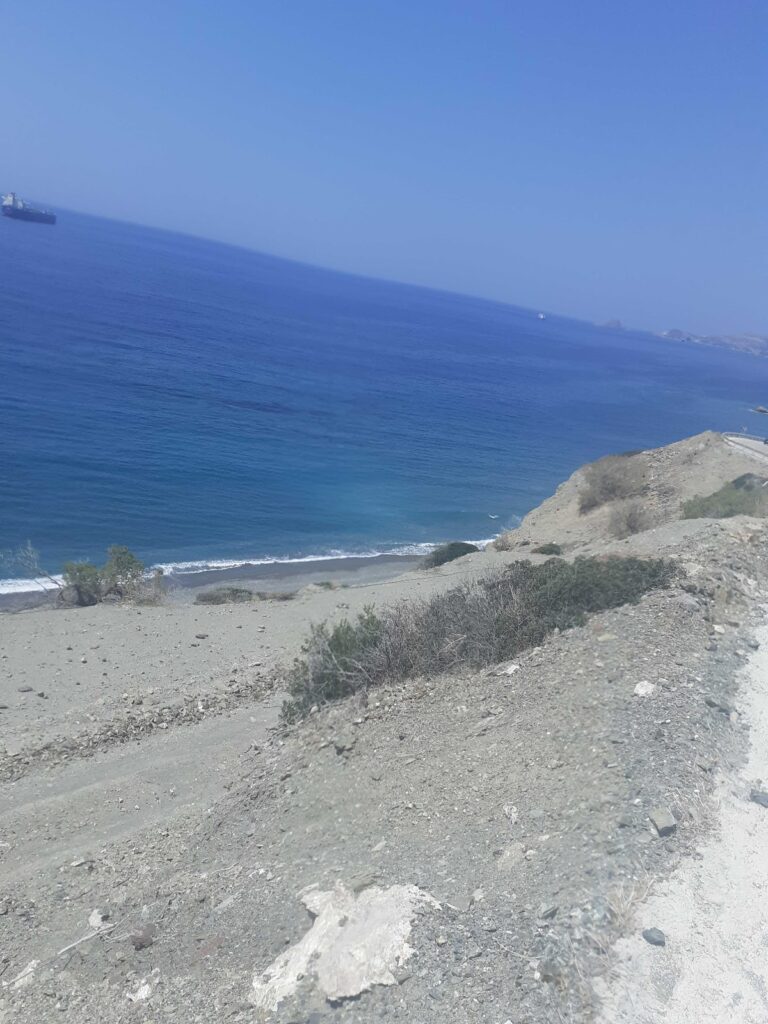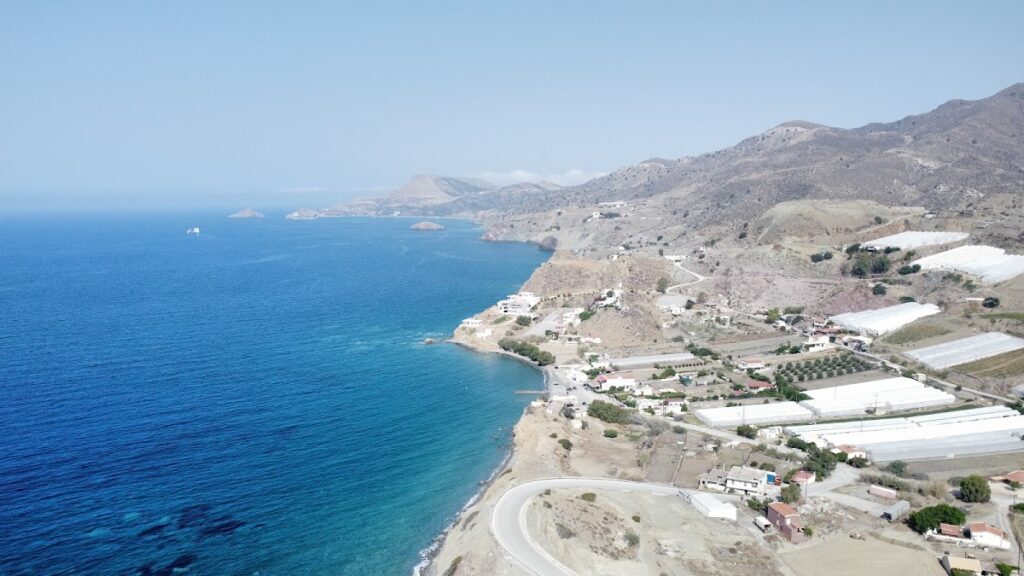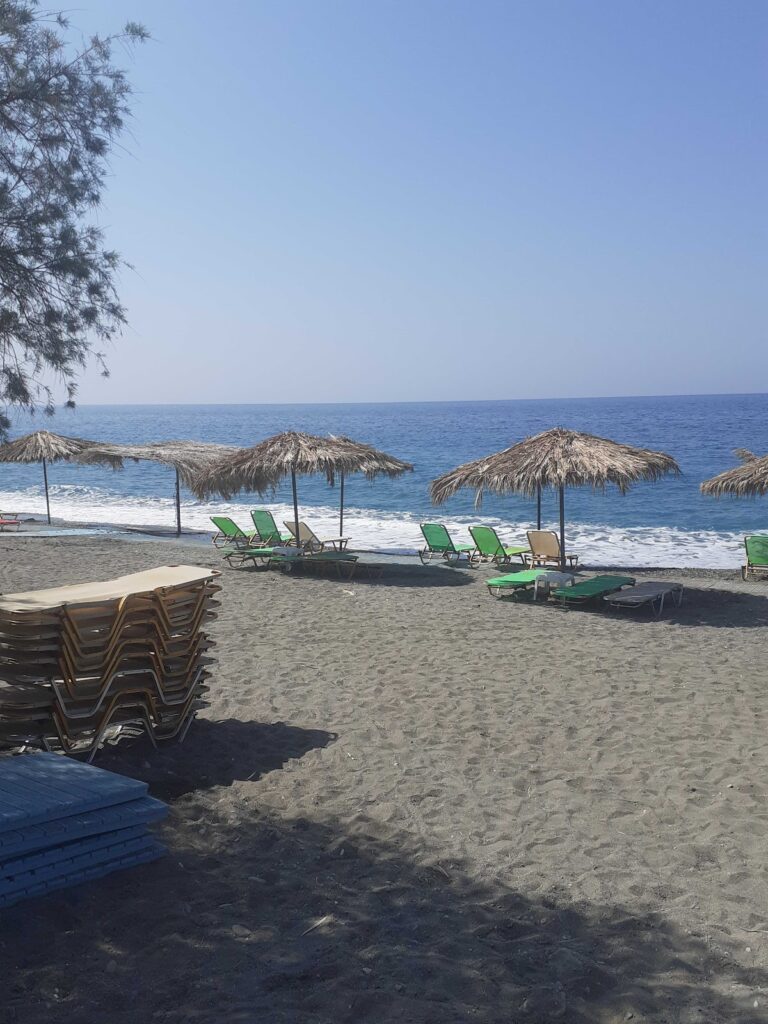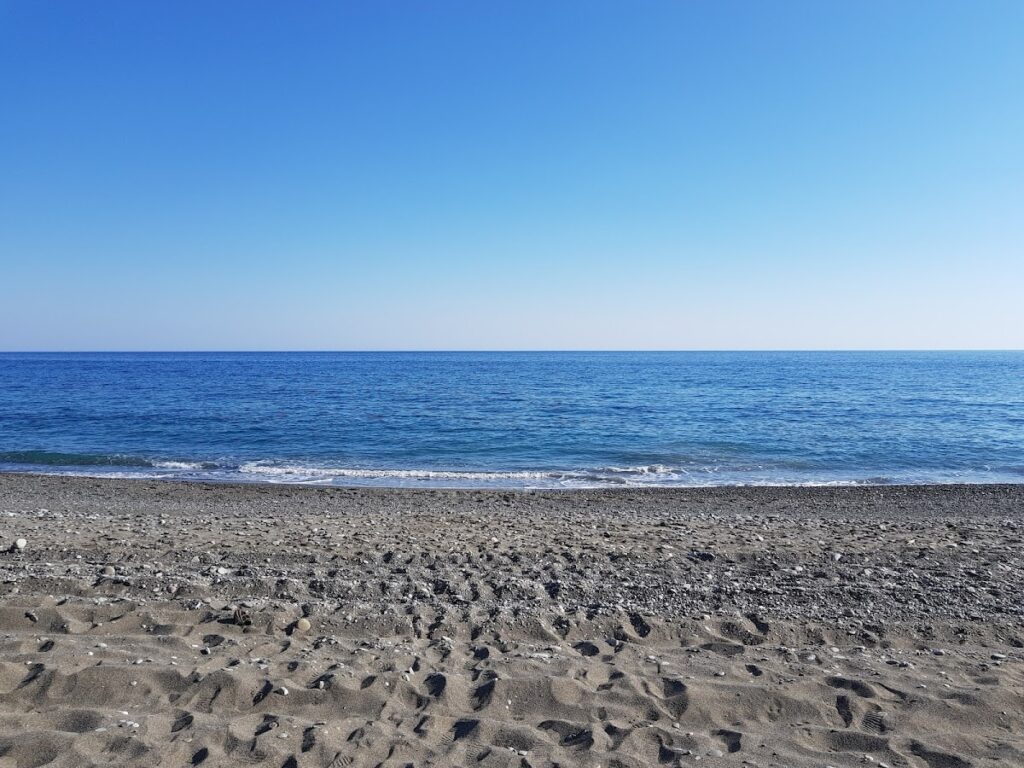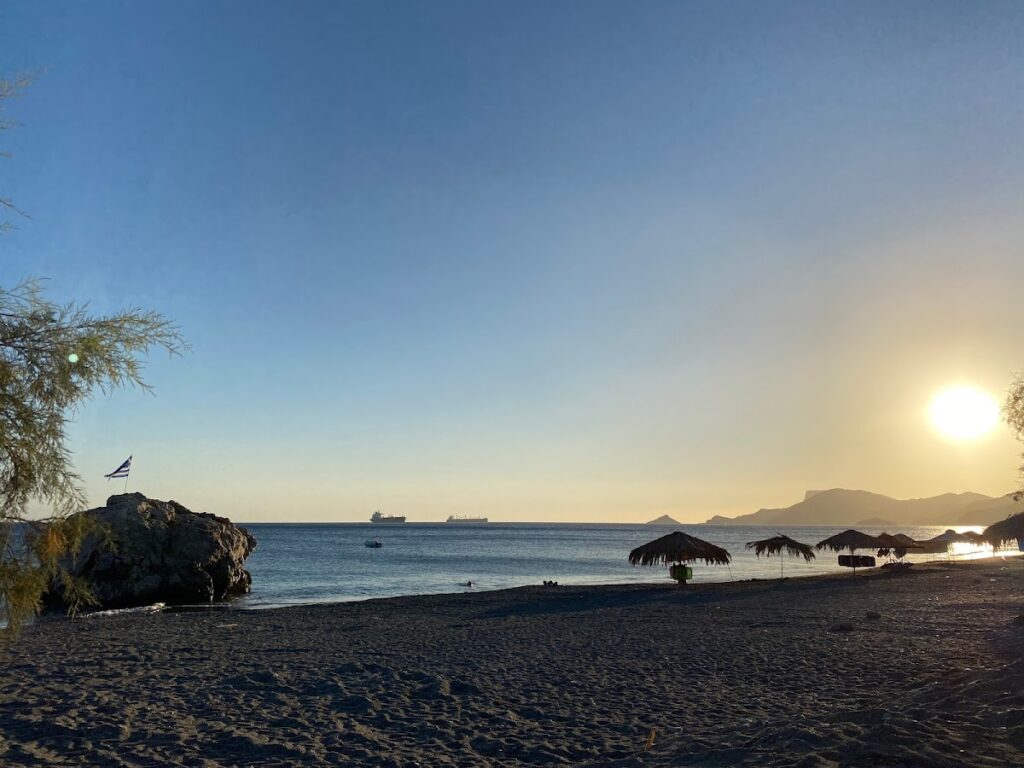Beaches near Kousés, in Heraklion region
Here is list of closest beaches to Kousés
- 6.5 km
- Komos beach
- Sand
- Normal
- Blue
Situated 66km southwest of Heraklion, Kommos (or Komos) lies a mere 2km north of Matala and in close proximity to Pitsidia village. It stands as the southernmost and remotest section of the extensive beachfront of Messara Bay. Once serving as the port of Phaestus, the remnants of the ancient port of Kommos can still be observed on the beach. It can be reached by driving towards Matala and following a sign to Kommos near Pitsidia.
The entire beachfront of Messara is exposed to the prevalent westerly winds. Visitors should exercise caution as the seabed can be rocky in certain areas. The beach also serves as a nesting ground for the protected loggerhead sea turtles (Caretta caretta) between the months of May and September.
Potamos or Potamoserma, the northern section of Kommos, is a popular spot among naturists, dating back to when hippies frequented the area. The location is dotted with sparse tamarisk trees and devoid of buildings due to its protected archaeological status, restricting construction. Next to the archaeological site in the south, there is a developed beach equipped with amenities such as umbrellas, sun beds, a toilet, showers, a canteen and a lifeguard. Surrounding sand dunes are home to white sand lilies that mark the end of summer. Nearby Kalamaki or Pitsidia and Matala offer options for accommodation and dining.
The sight of Paximadia islets during sunset is breathtaking. A large rock, known locally as Volakas, stands 300m out at sea, opposite the archaeological site. According to local lore, this rock is the tip of the boulder that the blinded Cyclops Polyphemus hurled at Odysseus’ ship to prevent his escape, following Odysseus and his crew’s escape from Polyphemus’ cave.
Kommos, the ancient port of Phaestus, was established around 200BC. However, it was subsequently destroyed by an earthquake and then rebuilt at the same location. The archaeological site of Komos, not open to the public, houses a Minoan harbour, public buildings, warehouses, oil presses, shipyards and a large courtyard. Archaeologists have uncovered a small temple, constructed on the ruins of an older one.
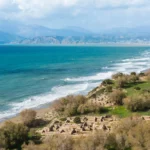
- 6.7 km
- Kalamaki beach - Heraklion
- Fine Pebbles, Rocks in places
- Normal
- Blue
Kalamaki, a quaint seaside hamlet, is nestled between Matala and Kokkinos Pirgos, 65km southwest of Heraklion. The beach, a 2.5km stretch of the vast Messara Bay coastline, graces the village’s front. Its sandy shore is kissed by the sea, which conceals a slick, flat rock bed beneath its surface. It features large waves, usually stirred by northwest winds, making beach access challenging at times due to the rocky seabed.
The village-facing part of the beach is well-equipped with sunbeds, umbrellas, eateries, accommodation, a lifeguard, playground, and water sports. For a more isolated experience, head southeast towards Kommos beach, a favorite among nudists.
To the north, you’ll find Afratias and the Pahia Ammos beach, which features patches of rocks. Devoid of amenities, the beach does boast a small park used for hosting cultural events like concerts during summer months.
Further north lies the Timbaki military airport, now serving as a resort for Greek Air Force staff. Although the beachfront is accessible, trespassing beyond the fence is prohibited and could lead to arrest. Sometimes, parachuters and skydivers can be spotted descending from small aircraft, courtesy of a local club based at the airport. In 2008, a small plane crashed into the Kalamaki sea, with the pilot miraculously surviving the ordeal. The Tymbaki airport holds ecological significance for the Mesara plains as it’s intersected by the Geropotamos River, which flows out to the beach. This river, the area’s largest, serves as a sanctuary for hundreds of rare birds across its numerous ponds.
The sandy coast of Messara Bay is a protected breeding ground for the loggerhead sea turtle. To prevent nest destruction and avoid frightening these creatures, it’s best not to roam the beach’s darker areas during summer nights.
Although Kalamaki doesn’t boast a significant history due to its relatively new establishment, it’s a popular seaside resort for Kamilari locals. Some believe it once served as a small harbor for Phaestus or Gortys in ancient times, though no concrete evidence supports this claim.
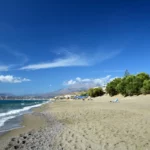
- 8.0 km
- Matala beach
- Fine Pebbles, Sand
- Deep
- Blue, Green
The beach of Matala is situated 68km southwest of Heraklion, where the Messara plain and Asteroussia Mountains intersect. It is one of the most frequented tourist spots in Crete and the most well-known beach in the southern region of the Heraklion prefecture. Matala is notable for its rock-carved caves and its association with the hippie culture of the 1970s. It lies in close proximity to Phaestus, the second largest palace of the Minoan civilization, having once served as its port. During the era of the Romans, Matala transformed into a port for Gortyn.
Nestled at the end of a small valley, Matala overlooks an enclosed bay with a picturesque view of the Paximadia islands. The beach spans 300m and features beautiful sandy shores, fine gravel, and crystal-clear deep waters. However, parts of the seabed, particularly the central area, are quite rocky and waves are common due to frequent westerly winds. A large cave can be found on the northern part of the beach, from which some thrill-seekers dive.
Matala beach is well-equipped with amenities such as umbrellas, restrooms, showers, lifeguards, first aid facilities, beach volleyball courts, snack bars, water sports, excursion boats, and a camping site. The surrounding area of Matala offers a range of accommodation, dining, and entertainment options. The beach is largely shaded by tamarisk trees, providing a respite from the sun. Come evening, the beach bars are brimming with people, both locals and tourists. The internationally acclaimed Matala Festival draws large crowds every June.

- 8.3 km
- Red beach
- Sand
- Normal
- Blue, Green
The Kokkini Ammos, or Red Beach, can be found 68km southwest of Heraklion and a short 800m from the popular resort of Matala. You can reach this hidden gem by following a clearly marked trail from Matala, which takes you over Kastri hill. While the trail includes some initial rock climbing and a steep descent at the end, it’s quite feasible. After a 15-25 minute walk from Matala, passing through a shepherd’s gate along the way, the breathtaking Red Beach comes into view. It’s an ideal spot for enjoying panoramic views and beautiful sunsets. Alternatively, you can also reach the beach by boat from Matala Harbour for a small fee of around 5 euros.
The beach is most noted for its red sand, a result of the area’s unique geology, which forms a stunning contrast against the bright blue-green sea. However, it’s important to note that it’s not shielded from the typical western winds in the region. The beach has minimal facilities, with a simple stone-wall coffee shop that opens occasionally offering food and drinks, and some umbrellas. It’s recommended to bring your own mats and umbrellas as the only natural shade is provided by a few tamarisk trees near the canteen.
In the 1960s and 70s, Red Beach was a popular spot among hippies, and its legacy continues with enthusiasts still visiting the beach regularly. Especially the northern part of the beach has gained a reputation as a nudist-friendly area and has gained international recognition for this. The beach and its surrounding area are protected by the Natura 2000 program due to its ecological importance.
The northern end of the beach features a long rocky limestone formation, similar to the limestone found in Matala. These rocks are decorated with carvings of Minoan and Egyptian sea figures, created by Gerard, a Belgian fan of Matala. These carvings have become a key part of the beach’s appeal. Between Matala and the Red Beach, there’s a large rock known as Theosini that offers stunning views of Messara Bay. This rock has been eroded by the sea, creating a marine cave known as Kouroupi, which can only be accessed by boat. The cave is a haven for endangered Mediterranean seals and various species of wild pigeons.
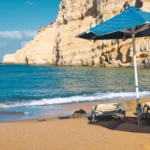
- 8.8 km
- Maha beach
- Fine Pebbles
- Deep
- Deep blue
Just about 1km eastward from the Chrysostomos settlement, you’ll come across the stunning Maha beaches. The first beach, primarily used as a harbour, is rocky and unorganized. However, there are a few rooms and a tavern in close proximity, with a road that leads right to the beach. If you continue to follow the dirt pathway that runs parallel to the beach towards the east, you’ll discover another breathtaking beach after about 100m. This beach boasts fine pebbles and deep, crystal blue waters. Although there are no trees to offer shade, there’s a cave on the eastern side of the beach that provides some respite from the sun. Do note that camping is prohibited here, as indicated by the signs scattered around the area.
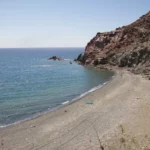
- 8.8 km
- Krigi beach
- Fine Pebbles
- Normal
- Blue
To the west of the village of Platia Peramata, you’ll discover the humble settlement known as Krigioi, with its array of unlawfully constructed homes and cottages. A brief drive along the local stream leads you to a stunning beach adorned with fine pebbles and crystal clear water. The uniqueness of Krigi lies in its numerous miniature beaches that stretch along the coast to Platia Peramata and the awe-inspiring soft limestone formations.
Overlooking Krigi is the quaint chapel of Saint Demetrius. To its west, you will find another secluded pebbly beach, Aspros Harakas, or White Rock, named for the pale rocks at its western end. However, Aspros Harakas may not appeal to everyone as it can only be reached by boat, boasts large stones and lacks shade.
Venturing further westward, you’ll stumble upon the three consecutive beaches of Kokkines Plakes, or Red Rocks. True to their name, these beaches are surrounded by reddish rocks and are primarily accessible via the sea.

- 8.9 km
- Lassea beach
- Fine Pebbles, Sand
- Normal
- Blue
Chrysostomos, a quaint seaside hamlet, is situated 75km to the south of Heraklion and 3km to the east of Kali Limenes. This small community features a few local taverns, a mini market, and available lodging. It takes its name from the decaying church of Saint John Chrysostomos located on the eastern side of the settlement. Chrysostomos is established on the ancient city of Lassea’s site, which Saint Paul visited during his time on Crete. Lassea served as a port for the Roman city Gortys, the then capital of Crete and Libya in the Roman era, and was rich in copper resources.
Lassea’s beach, in front of the village, is a picturesque spot featuring coarse sand and shelter from westerly winds. It’s not commercialized, but is conveniently close to the village. On the beach’s western edge, a rocky outcrop extends towards the small islet of Trafos, marking the ancient port of Lassea’s old pier. These rocks have been there since the 1960s, when they were used to construct the Oil Tanks of Kali Limenes. The ancient town of Lasea’s remnants are still visible on the beach and the islet. The beach extends beyond Trafos to the west, forming a separate beach known as Segrezo Ryaki that faces westward. This beach is proximate to a Roman cemetery and is secluded, ideal for nudists, but has more rocks than the main beach. At the westernmost point, there’s a freshwater spring.
To get here from Kali Limenes, take the paved road that begins 1km east of Kali Limenes and head east towards Platia Peramata. After about 2km, you will encounter the village of Chrysostomos on your right.
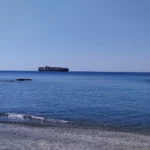
- 9.1 km
- Platia Peramata beach
- Fine Pebbles, Pebbles
- Shallow
- Blue
Platia Peramata, a quaint village situated 69km south of Heraklion and 7km east of both Kali Limenes and Lendas, nestles at the exit of a small, fertile valley that cuts through the rugged Asterousia Mountains. This valley begins at Antiskari village and concludes in a settlement, its rich soil used for growing early vegetables like tomatoes, cucumbers, and peppers in greenhouses due to the consistently high temperatures.
The region features numerous adjacent bays that form serene and picturesque beaches, frequented primarily by locals. At the heart of the settlement lies the small beach of Platia Peramata, known for its fine pebbles which are predominantly used to moor the locals’ boats. Despite the beach’s lack of extensive facilities, a handful of tavernas and rooms are available nearby. Tamarisk trees line the beach and are often used as camping spots. To the east of the settlement, East Platia Peramata beach, less favored by swimmers, offers another pebbly shoreline.

- 9.3 km
- Psili Ammos beach - Heraklion
- Fine Pebbles, Sand
- Normal
- Blue
The longest beach in the region, Psili Ammos, is situated to the east of the village Platia Peramata. This secluded and stunning beach does not cater well to camping due to the lack of tree shade. Still, at the eastern extremity, one can find large white rocks known as Asproharaki, which provide shade to those fortunate enough to claim them. The beach was thrust into prominence in 2010 when a significant Russian oil tanker was stranded there during a storm. Thankfully, no one was at risk and no environmental harm was done.
Paliomandra beach
On your way to Psili Ammos from Tsigounas, you will encounter several minor beaches. The furthest east cove, reachable via a dirt road, is known as Paliomandra and is rather secluded. The beach features coarse sand and a rocky seabed, making it ideal for fishing and snorkeling.
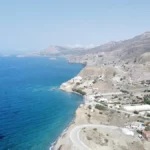
- 9.6 km
- Kali Limenes beach
- Fine Pebbles, Sand
- Normal
- Blue
Kali Limenes, also known as Good Ports, is a seaside village in the Asterousia Mountains, situated 75km southwest of Heraklion. It’s one of the few coastal regions of Asterousia accessible via asphalt road. Reaching this place requires a drive from Pompia village, through Messara Plane, and onto Pigaidakia village. Despite the road being narrow and loaded with sharp turns, the journey is worthwhile. An alternative dirt road from the Monastery of Odigitria, also leading to Kali Limenes, can be paired with a beach visit to Agiofarago.
Upon arrival, you can’t miss the oil tanks of SEKA stationed on the island Mikronisi, locally known as “Apostle Paul”. Kali Limenes is a lesser-known spot for Greeks, but the Vardinoyannis family, one of Europe’s wealthiest, is well-known. They began their empire in 1961 with these tanks, serving as a refuelling station for ships crossing the Mediterranean and the Suez Canal. Despite the visual pollution these facilities bring, the sea remains pristine.
Ignoring the unsightly tanks, the stunning beaches of Kali Limenes will undoubtedly captivate you. Suitable for year-round swimming, the sea, true to its name Fair Harbors, remains calm most of the year, except in winter. The calmness was a factor in the placement of the tanks. Weekends bring crowds to these beaches, undeterred by the challenging journey through Asterousia.
Maria Ammos, or Long Sandy Beach, is the first beach you’ll encounter coming from Pigaidakia. It’s a lengthy beach with greyish pebbles and deep waters. As you move east, the coast grows increasingly tranquil. Maria Ammos is a popular spot for nudists, and campers are drawn to the shade-providing tamarisk trees lining the coast. The beach may not be well-organized, but you’ll find a few eateries and hotels to the west.
Kali Limenes village, west of Makria Ammos, is nestled amidst lush olive groves. A quaint bay and harbour grace the village’s front, along with the child-friendly Psili Ammos, or Fine Sandy Beach. This beach, the busiest in the area, is lined with restaurants, a mini market, and rented rooms.
The hill west of Kali Limenes houses the chapel of St. Paul. It was built in 1700 in honor of the Ecumenical Patriarch Bartholomew’s visit in 1992 and 2008. You can also explore a nearby cave, believed to have housed Apostle Paul for two years. The gorgeous beach of Stena is also worth a visit.
East of Kali Limenes, a road leading to Chrysostomos will bring you to Karavovrysi beach after a 2km journey and a short walk. It’s a stunning beach with coarse sand and calm water. But be ready to bring your own shade as there are no trees.
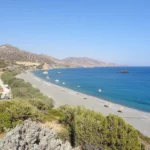
No results available
ResetBeaches in other nearby areas
No results available
Reset